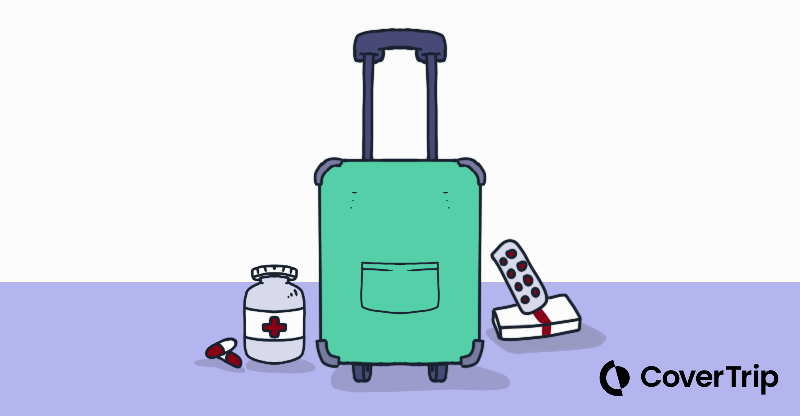How to Travel with Medications Safely
26 September 2025
Many travelers discover too late that their routine pills can create serious complications at security checkpoints, customs, or when emergencies strike abroad. From common medications that are illegal in popular destinations to time zone confusion that leads to missed doses, the challenges of managing a prescription med regimen are real – but entirely manageable with the right preparation.
The key is understanding that medication travel isn’t just about packing pills; it’s about documentation, timing, legal compliance, and having backup plans when things go wrong.
This guide covers the essential strategies that can save you from costly delays, confiscated prescriptions, or dangerous gaps in your medication schedule. Smart preparation means you can focus on enjoying your trip instead of worrying about your next dose. Here’s how to travel safely with prescription medications.

Before You Pack: Essential Preparation Steps
Start your medication research at least 4-6 weeks before departure, especially for international trips. Some countries strictly prohibit common medications like Adderall, codeine-based painkillers, or even certain over-the-counter sleep aids, while others require special permits or have quantity restrictions.
Your best first stop is taking a look at the Medicine and Health section of the US State Department website.
Essential documentation and packing steps:
- Get a letter from your prescribing physician on official letterhead (include your name, medication names both brand and generic, dosages, and medical condition)
- Calculate medication needs generously – pack at least 50% extra beyond your trip length – and divide them between your carry-on and checked bags (in case one gets lost or stolen)
- Keep all medications in original pharmacy containers with current labels (so they’re legitimacy isn’t questioned)
- Never transfer pills to weekly organizers – it creates unnecessary complications at security and customs
Pro tip: For controlled substances, contact the embassy for current regulations. What’s legal in one country may not be in another, and ignorance isn’t a defense at customs.
Getting Through Security and Customs Safely
The TSA allows prescription medications in both carry-on and checked bags without quantity limits, but liquid medications over 3.4 ounces must be declared separately at security checkpoints. Remove these larger liquid medications from your bag and inform the TSA agent – they’ll likely test them with additional screening, so build extra time into your airport arrival.
For controlled substances like opioids or ADHD medications, keep your prescription label clearly visible and carry that doctor’s letter we mentioned earlier.
Key security and customs guidelines:
- Declare all prescription medications at international customs, even if they seem routine to you
- Keep a complete medication list (with generic names) easily accessible in your carry-on
- For medical devices like insulin pens or inhalers, inform security agents before screening begins
- Never carry medications for someone else – even family members – as this can trigger serious legal issues
FYI: Some countries have strict “personal use” quantity limits (typically 30-90 days’ worth) to prevent drug trafficking. Carrying a six-month supply of any medication, even with a prescription, can raise red flags and result in confiscation or fines. If you plan to be traveling for a significant length of time, you’ll need (at the very least), a doctor’s letter and a plan to purchase and/or replace medications along the way.
Managing Time Zones and Dosing Schedules
The key to managing medications across time zones is planning your transition before you travel, not figuring it out mid-flight. For most medications taken once daily, you can simply switch to local time upon arrival without major complications. However, critical medications like insulin, blood thinners, or heart medications require more careful timing adjustments.
While you should never travel soon after being prescribed a new medication regimen, if you have any concerns about adjusting your meds by timezone, give your doctor a call at least two weeks prior to your trip so you can get some advice.
Smart strategies for medication timing:
- For eastward travel (shorter days), consider taking your dose slightly later each day leading up to departure
- For westward travel (longer days), you may need an extra dose or adjusted timing on travel day
Here’s how to use your phone’s world clock to track both home and destination times during travel days.
iPhone users
- Open the Clock app and tap “World Clock” at the bottom
- Tap the “+” to add your destination city
- Label one clock “HOME MEDS” and another “DESTINATION” so you can quickly see both times
- Set alarms for your medication times in both time zones during travel days
Android users
- Open the Clock app and select “World Clock”
- Add both your home city and destination
- Use the alarm function to set reminders that show both time zones
- Some Android phones let you add widgets to your home screen showing multiple time zones
During travel:
- Keep both clocks visible so you can see “it’s 8am medication time at home, but 2pm at my destination”
- This helps you decide whether to take your dose now or wait
- Especially useful during long flights when you lose track of time zones
The key is having both times visible at a glance rather than trying to calculate time differences in your head while jet-lagged.
Pro tip: If you take medications twice daily or more, maintain your home schedule for the first 24-48 hours, then gradually shift to local time. This prevents dangerous gaps or double-dosing during the transition period when your body clock is still adjusting.
Finding Help When Things Go Wrong
Medication emergencies happen more often than you’d think – your backpack gets stolen with your pills inside, your medication is confiscated at customs for an obscure regulation, or you simply run out during an extended trip due to flight delays.
When any of these situations occur, your travel insurance should be your first call, not your last resort.
Most comprehensive travel insurance policies include 24/7 medical assistance hotlines staffed with professionals who can locate English-speaking pharmacies, arrange emergency prescription transfers, and even coordinate with your home doctor to get replacement medications approved quickly.
Steps to take during a medication emergency:
- Call your travel insurance emergency hotline immediately
- Have your policy number, prescription info, and doctor’s contact information ready when you call
- If your meds are confiscated, request documentation to help you make an insurance claim
- Use your insurance’s provider network to find approved pharmacies where costs may be covered or reimbursed
- Keep all receipts for emergency medication purchases – most policies reimburse these expenses
Pro tip: If you’re traveling without comprehensive travel insurance, contact the nearest U.S. embassy or consulate for their list of English-speaking medical facilities. However, you’ll be paying out-of-pocket and handling coordination yourself – a compelling reason to invest in good travel insurance before your next trip.
Damian Tysdal is the founder of CoverTrip, and is a licensed agent for travel insurance (MA 1883287). He believes travel insurance should be easier to understand, and started the first travel insurance blog in 2006.
